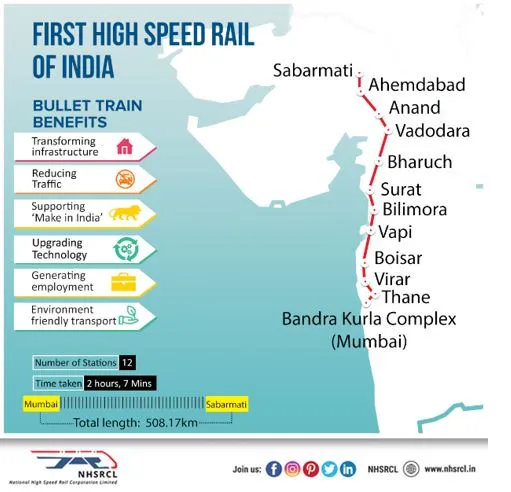

4th July 2024 (10 Topics)
Context
The Mumbai-Ahmedabad bullet train is expected to begin operations in Gujarat by 2027 end and will later be extended to Maharashtra, according to the National High Speed Rail Corporation Limited (NHSRCL).
About Mumbai-Ahmedabad Bullet Train Project:
- The foundation stone for the Mumbai-Ahmedabad bullet train project was laid in 2017.
- Speed and Distance: The bullet train will zip along at 320 kmph, covering the 508.17 km distance between Mumbai and Ahmedabad in just about two hours.
- Cost and Completion: Estimated at Rs 1.65 lakh crore, the project is slated for completion by 2028.
- National High-Speed Rail Corporation Limited: Established under the Companies Act, 2013, NHSRCL aims to finance, construct, maintain, and manage high-speed rail corridors across India.
- The Need for High-Speed Rail
- Challenges of Indian Railways: With over 67,415 route km, Indian Railways forms the backbone of the nation's transport system. However, overcrowding on main routes, with some operating at 150% capacity, has slowed down travel speeds and shifted traffic to less efficient road transport.
- Logistical Constraints: Congestion on rail routes increases turnaround times for goods, impacting manufacturing efficiency and competitiveness.
- Benefits of High-Speed Rail
- Capacity Release and Safety: High-speed rail will alleviate congestion on existing lines, enhancing passenger safety and comfort.
- Environmental Impact: Powered by indigenous electric power, high-speed rail reduces dependence on imported fuels, lowering greenhouse gas emissions.
- Airport Congestion: By reducing short-haul flights, high-speed rail frees up airport capacity for more economical long-haul flights.
- Global Examples: Successful implementations in Japan, Europe, and China demonstrate how high-speed rail enhances connectivity and boosts economic growth.
- A study found that towns connected by high-speed rail saw their GDP riseby at least 2.7 per cent compared to those not on the route.

More Articles

